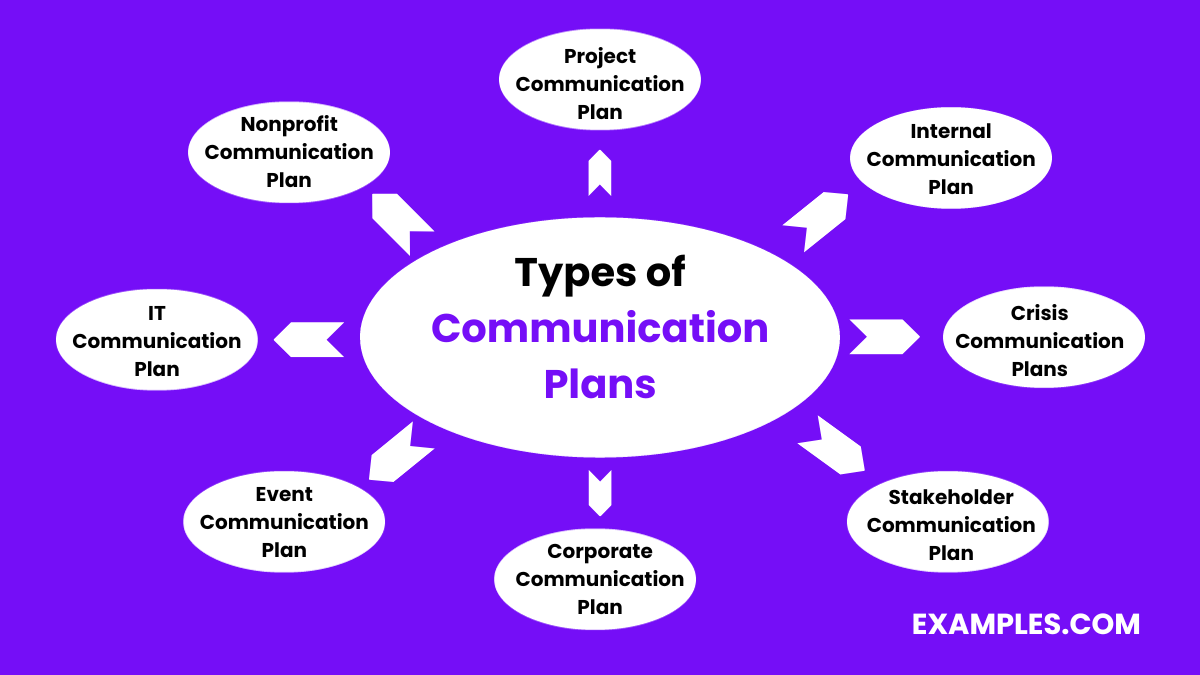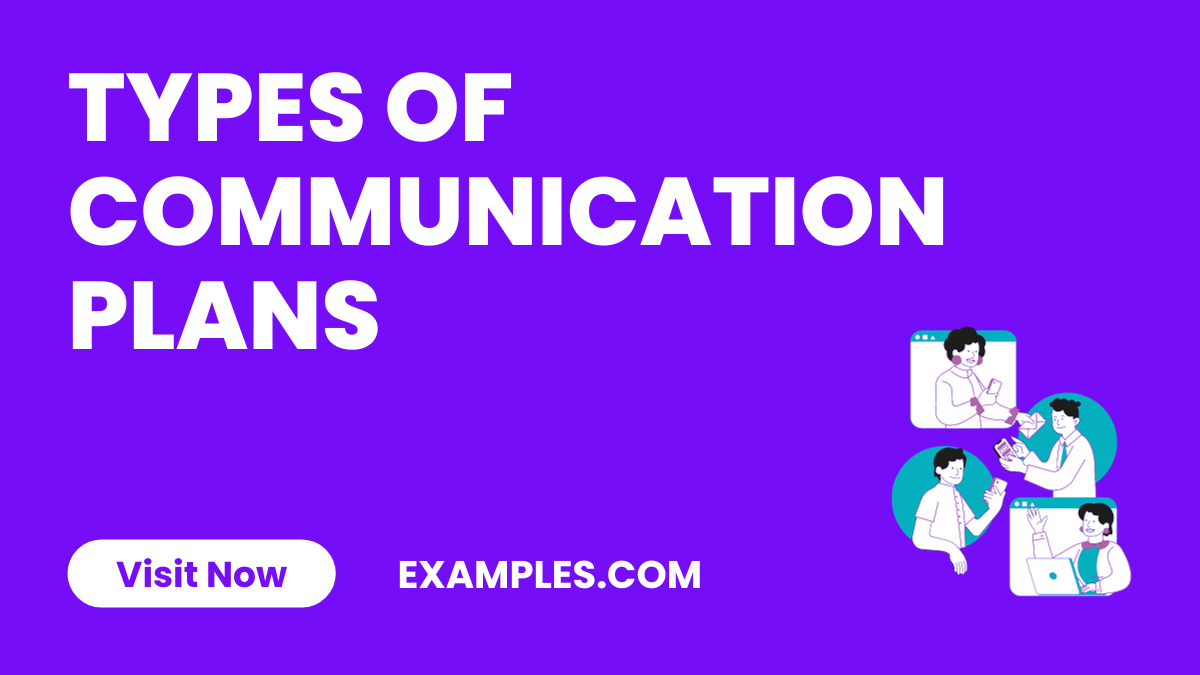Types of Communication Plans: Examples, Types, Pdf
In today’s interconnected world, understanding the types of communication plans is essential for successful interactions. Whether it’s for business, personal, or educational purposes, effective communication strategies can significantly impact your outcomes. This guide explores various communication plans, detailing their purposes, and providing real-world communication examples. Dive into the nuances of each plan, understand their unique characteristics, and learn how to implement them effectively. Enhance your communication skills and ensure your messages are not just heard but also understood and acted upon.
Download Types of Communication Plans Bundle
Types of Communication Plans

Types of Communication Plans are diverse and tailored to meet various organizational needs, each designed with specific goals in mind. A Communication Plan for Change Management is crucial for guiding employees through organizational changes, ensuring everyone understands and supports the transition. Meanwhile, communication strategy, detailing objectives, audiences, messages, and channels. A Strategic Communication Plan focuses on aligning communication efforts with the organization’s long-term goals, while a Communication Management Plan ensures all aspects of communication are systematically organized and implemented.
An Effective Communication Plan is one that successfully reaches and engages the intended audience, leading to the desired outcome. In educational settings, a School Communication Plan is vital for ensuring parents, students, and staff are well-informed and aligned with school policies and events. On the other hand, a Communication Improvement Plan is designed to address and enhance weak areas in an organization’s communication process.
The Elements of Communication Plan typically include objectives, target audiences, key messages, channels, and evaluation methods. An Integrated Communication Plan ensures consistency across all platforms and messages. For smaller projects or organizations, a Simple Communication Plan might suffice, providing a clear, concise framework without overwhelming details. Lastly, a Comprehensive Communication Plan is extensive, covering all possible aspects and scenarios of communication within a complex project or organization. Each of these plans plays a crucial role in ensuring that communication is clear, consistent, and effective, contributing to the overall success and harmony of the entity they serve.
Project Communication Plan
The Project Communication Plan focuses on the flow of information between the project team and stakeholders. It defines how updates, decisions, and issues will be communicated, ensuring consistent and timely sharing of critical project details to avoid misunderstandings and keep the project on track.
Internal Communication Plan
An Internal Communication Plan is designed to streamline communication within an organization. It outlines the strategies for effective information sharing among employees, management, and departments. The goal is to foster an environment of transparency, collaboration, and alignment with the organization’s objectives.
Crisis Communication Plans
Crisis Communication Plans are prepared to address and manage communication during unexpected, often negative events. They outline the procedures for disseminating information to employees, stakeholders, and the public promptly and effectively, helping to mitigate the impact and maintain the organization’s reputation.
Stakeholder Communication Plan
A Stakeholder Communication Plan ensures that all project or organization stakeholders receive timely and relevant information. It identifies the stakeholders, their information needs, and the method and frequency of communication, ensuring that expectations are managed and support is maintained.
Corporate Communication Plan
The Corporate Communication Plan encompasses strategies for how a corporation communicates with its employees, stakeholders, and the public. It covers a range of activities from branding and public relations to internal communication, aiming to convey a consistent, positive corporate image.
Event Communication Plan
An Event Communication Plan is crucial for the seamless execution of any event. It details how information will be communicated to attendees, staff, and stakeholders before, during, and after the event, covering aspects like marketing, emergency procedures, and updates.
IT Communication Plan
An IT Communication Plan outlines how technology-related information will be shared within an organization. It’s crucial for ensuring users are informed about system updates, outages, and security protocols, thus minimizing disruptions and enhancing the efficiency of IT operations.
Nonprofit Communication Plan
A Nonprofit Communication Plan focuses on how the organization will convey its mission, campaigns, and impact to the public, donors, and volunteers. It’s essential for building support, transparency, and engagement in pursuit of the nonprofit’s goals..
Communication Plans for Schools
Communication Plans for Schools are designed to ensure clear, consistent, and effective communication between the school, parents, students, and the community. They cover academic updates, events, emergencies, and policies, playing a crucial role in the educational environment.
Emergency Communication Plan
An Emergency Communication Plan outlines the procedures for disseminating information quickly and effectively in a crisis. It’s vital for ensuring safety, reducing confusion, and coordinating a response among employees, authorities, and the public.
External Communication Plan
An External Communication Plan focuses on how an organization communicates with parties outside of its immediate environment. It covers aspects like public relations, media interactions, and customer communications, aiming to build a positive public image and stakeholder relations.
Team Communication Plan
A Team Communication Plan is crucial for ensuring team members are on the same page. It outlines how and when team members will communicate, share updates, and collaborate, fostering efficiency and unity within the team.
Annual Communication Plan
An Annual Communication Plan lays out an organization’s communication strategies for the year. It aligns with the organization’s goals and includes campaigns, key messages, and channels to be used, ensuring a structured and strategic approach to communication.
Disaster Communication Plan
A Disaster Communication Plan is a subset of crisis communication specifically focusing on natural or man-made disasters. It includes procedures for alerting, informing, and instructing all affected parties to minimize harm and confusion during such events..
Hazard Communication Plan
A Hazard Communication Plan is essential in workplaces where employees are exposed to hazardous materials. It outlines how information about the hazards and protective measures will be communicated to ensure safety and compliance with regulations.
Social Media Communication Plan
A Social Media Communication Plan details how an organization or project will use social media channels to communicate with its audience. It includes the content strategy, posting schedule, engagement tactics, and monitoring methods to effectively use social media.
Communication Plan for Church
A Communication Plan for Church facilitates the sharing of information among the congregation, leaders, and community. It covers services, events, announcements, and outreach efforts, aiming to foster a connected and informed spiritual community.
Communication Plan for Employees
A Communication Plan for Employees ensures that all staff members are informed about company updates, policies, and initiatives. It contributes to a transparent and inclusive work environment, enhancing employee engagement and satisfaction.
Communication Plan for Teachers
A Communication Plan for Teachers focuses on how educators will communicate with students, parents, and administrators. It includes methods for sharing academic progress, updates, and school-wide information, ensuring a supportive and effective educational environment.
Project Management Communication Plan
A Project Management Communication Plan is essential for ensuring all stakeholders are informed and engaged throughout a project’s lifecycle. It outlines the information to be shared, the methods of communication, frequency, and parties responsible. This plan is vital for maintaining transparency, managing expectations, and facilitating collaboration.
The webpage on Communication Plan Description emphasizes the importance of developing a comprehensive communication plan for effective risk communication in organizations. The plan involves a multi-step process, including identifying issues, setting goals and objectives, and understanding community dynamics. It highlights the significance of using various communication tools and techniques to engage stakeholders effectively. The plan aims to build trust and credibility, ensure effective message delivery, and adapt to changing situations and stakeholder needs. This strategic approach facilitates better understanding and management of risks within organizational and public contexts.
The article How to Create an Internal Communication Plan in Easy Steps on fivedash.org outlines a structured approach to developing an effective internal communication strategy. It emphasizes the importance of evaluating the current communication situation, understanding the audience, and establishing clear goals. The plan involves determining strategies and tactics, executing them, evaluating the plan’s effectiveness, and making necessary modifications. This comprehensive process aims to enhance organizational communication, ensuring informed and engaged employees aligned with company objectives.



